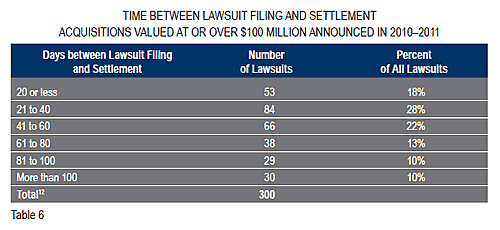John Gould is Senior Vice President at Cornerstone Research. This post is based on a Cornerstone Research report prepared in cooperation with Professor Robert Daines of Stanford Law School. The report, titled Recent Developments in Shareholder Litigation Involving Mergers and Acquisitions, is available here. For more information, contact Mr. Gould or Olga Koumrian. An updated version of the report is available here.
Shareholder litigation challenging merger and acquisition (M&A) deals has increased substantially in recent years. To study this increase and characterize the recent litigation, Cornerstone Research and Professor Robert Daines of the Stanford Law School reviewed reports of M&A shareholder litigation in Securities and Exchange Commission (SEC) filings related to acquisitions of U.S. public companies valued over $100 million and announced in 2010 or 2011. [1] We found that almost every acquisition of that size elicited multiple lawsuits, which were filed shortly after the deal’s announcement and often settled before the deal’s closing. Only a small fraction of these lawsuits resulted in payments to shareholders; the majority settled for additional disclosures or, less frequently, changes in merger terms, such as deal protection provisions. Interestingly, while requiring additional disclosures is a common outcome, we have not encountered a case in which shareholders rejected the deal after the additional disclosures were provided.
In this report, we provide statistics on recent M&A shareholder lawsuits, describing their prevalence, filing timelines, venue choices, outcomes, and settlement terms.
Typical Allegations
Shareholder lawsuits objecting to an M&A transaction usually are filed as class actions or derivative suits. Shareholders typically allege that the target’s board of directors violated its fiduciary duties by conducting a flawed sales process that failed to maximize shareholder value. Common allegations include the deal terms not resulting from a sufficiently competitive auction, the existence of restrictive deal protections [2] that discouraged additional bids, or the impact of various conflicts of interests, such as executive retention or change-ofcontrol payments to executives. Complaints also typically allege that a target’s board failed to disclose sufficient information to shareholders to enable their informed vote. Insufficient disclosure allegations have focused on information related to the sale process, the reasons for the board’s actions, financial projections, and the financial advisors’ fairness opinions.
Prevalence
We identified 789 lawsuits filed for acquisitions of U.S. public companies valued at or over $100 million announced in 2010, and 696 lawsuits filed for such deals announced in 2011.
To examine a historical trend, we compared the number of M&A shareholder lawsuits valued at or over $500 million for deals announced in 2007 with those announced in 2010 and 2011 and found that the number of lawsuits increased almost twofold (Table 1).
Because M&A activity declined in 2010 and 2011 compared with 2007, [3] the increase in the number of lawsuits translates into a much higher incidence of lawsuits for 2010 and 2011 deals. Whereas only about half of the acquisitions announced in 2007 and valued at or over $500 million were challenged, almost every such acquisition in 2010 and 2011 was the target of litigation, and each challenged deal attracted many more lawsuits (Figure 1 and Table 1).
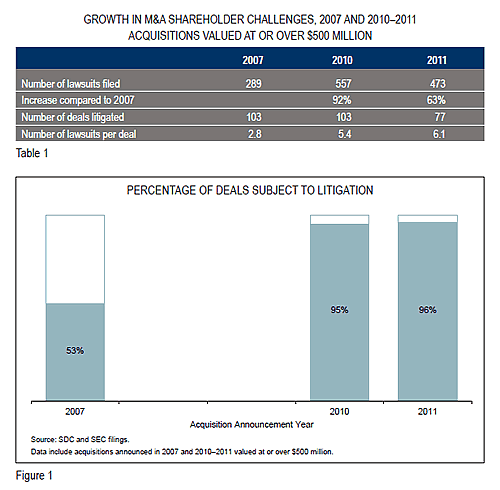
The high incidence of shareholder litigation is not limited to the largest deals. As shown in Table 2, the vast majority of deals announced in 2010 and 2011 and valued between $100 and $500 million were also challenged with multiple lawsuits per deal.

Table 3 shows the most litigated deals of 2010 and 2011—those that attracted fifteen or more lawsuits. These deals ranged in value from $280 million to $29 billion. While the value of the deal may contribute to the likelihood of M&A litigation, these data show that deal size is not the only determinant. The Blackstone acquisition of Dynegy attracted the most lawsuits but was valued at less than $1 billion. Relatively small acquisitions of Conexant Systems, Force Protection, and American Oil & Gas also attracted more than fifteen lawsuits.
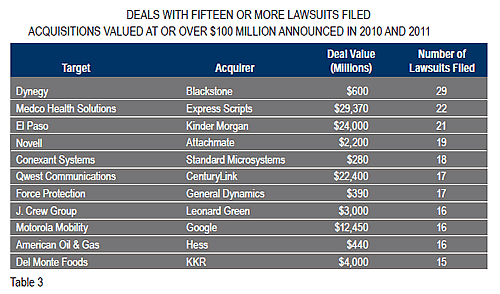
Filing Timeline
Some reports suggest that the increase in the number of lawsuits challenging the same deal has led to a “race to file” lawsuits after a deal is announced. [4] Our analysis confirms that filings have quickly followed deal announcements but does not show that a “race to file” has reduced the time to file in recent years as compared with 2007. We find that about twothirds of the lawsuits we identified were filed within two weeks after a deal’s announcement. Filing speed, however, has not increased for deals between 2007 and 2010–2011. On the contrary, as shown in Figure 2, the proportion of lawsuits filed in the first week after a deal’s announcement declined from 53 percent in 2007 to 45 percent in 2010 and to 40 percent in 2011. In all three years, approximately one-seventh of all lawsuits were filed more than four weeks after a deal’s announcement.
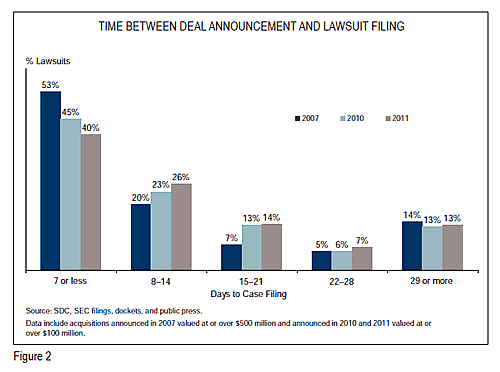
Choice of Venue
Traditionally, the Delaware Court of Chancery has been the venue of choice for litigation involving M&A targets incorporated in Delaware. [5] Beginning in the early 2000s, however, much of this litigation moved to other state courts, a trend that has attracted the attention of academic researchers and industry observers and prompted the term “flight from Delaware.” [6]
Our analysis confirms that many M&A lawsuits involving targets incorporated in Delaware are not filed in the Delaware Court of Chancery but also finds that the share of M&A lawsuits filed elsewhere has not increased since 2007. Approximately two-thirds of all lawsuits involving targets incorporated in Delaware were filed outside of the Delaware Court of Chancery. This percentage, however, has not increased between deals announced in 2007 and deals announced in 2010–2011 (see Table 4).

The most striking trend in venue choice for M&A litigation is not a flight from or return to Delaware, but that challenges to the same deal in both Delaware and some other venue are now more common (see Figure 3 [7]).
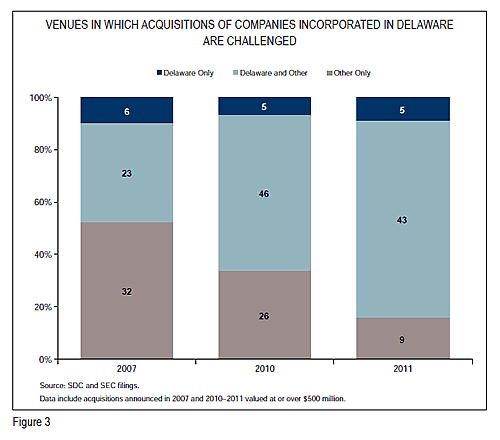
We also examined which state courts (other than the Delaware Court of Chancery) were most active in M&A shareholder litigation involving all targets. Most lawsuits brought in non-Delaware state courts were in California, Texas, and New York, likely reflecting where many deal targets are headquartered. To compare litigation across states, in Table 5, we report the average number of lawsuits filed per deal in each state and the average time between the deal announcement and the lawsuit filings. Texas and Illinois had the largest number of competing lawsuits, and Illinois and Washington had the fastest filers (on average, fewer than seven days). The bottom panel of the table shows that, on average, it took much longer to file in federal courts than in state courts.
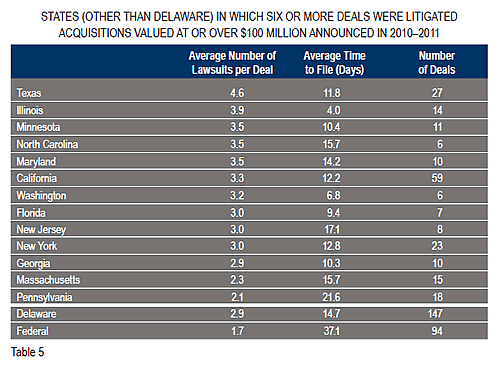
Outcomes
The data confirm that M&A shareholder lawsuits typically settle and often settle quickly. We were able to track to resolution 565 challenges of 2010–2011 M&A deals (76 percent of all proceeding lawsuits in our sample). [8] Of these lawsuits, 153 (27 percent) were voluntarily dismissed by the plaintiffs, twenty-three (4 percent) were dismissed by the court with prejudice, and 389 (69 percent) settled (see Figure 4).
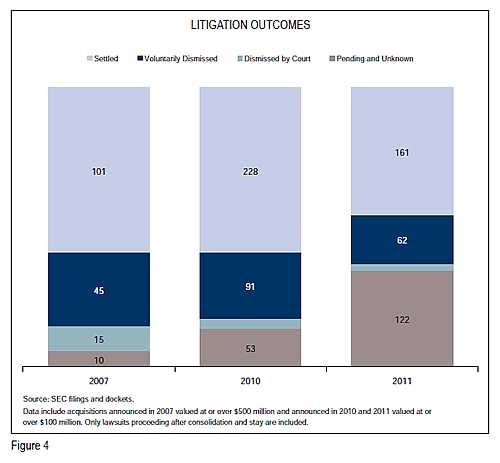
These findings show a significant change from the outcomes observed a decade ago. Thompson and Thomas (2004) examined M&A lawsuits filed in the Delaware Court of Chancery in 1999 and 2000 and found that 59 percent of these were dismissed and only 28 percent settled. [9]
Of the 190 unique settlements [10] we identified, 180 were reached before the merger closed. [11] Most of these were reached shortly before a hearing on the plaintiffs’ motion for preliminary injunction (restraining order) or shortly before the shareholder vote. The median time between lawsuit filing and settlement in this sample was forty-four days. Table 6 shows the distribution of the settlement time.
Settlement Terms
Settlement terms have changed over the last decade. Thompson and Thomas (2004) found that for lawsuits filed in Delaware in 1999 and 2000, the majority (52 percent) of settlements included cash awards, and only a fraction (10 percent) involved additional disclosures only. [13] This distribution has reversed in recent years. Of the 190 unique reported settlements related to 2010–2011 M&A deals, only nine (5 percent) resulted in payments to shareholders (Table 7), [14] and a large majority of settlements (156 or 82 percent of the sample) settled for additional disclosures only. Twenty-five settlements (13 percent) included merger agreement changes other than payments to shareholders. Fourteen of these (7 percent of the unique settlements) resulted in modified deal protection provisions (such as termination fee, no-solicitation, and matching rights). None of these changes resulted in a higher bid for the target. Other merger agreement changes included the terms of top-up option and appraisal rights. Eleven settlements (6 percent) involved other terms, most often a delay of the shareholder vote.

The largest of the recent settlements—an $89 million settlement in October 2011 in the Del Monte Foods buyout—attracted much attention in M&A circles. The Del Monte Foods case first made headlines in February 2011 when the Delaware Court of Chancery awarded a preliminary injunction of the shareholder vote. [15] The court focused on the allegation that Del Monte’s financial advisor, Barclays Capital, also helped with the buy-side financing of the deal and failed to disclose to the target its relationship with the buyer. Vice-Chancellor Laster opined that Del Monte’s board “fail[ed] to provide the serious oversight that would have checked Barclays’ misconduct.” The final $89.4 million settlement included a $23.7 million payment by Barclays. [16]
Plaintiff Attorney Fees
The amount of plaintiff attorney fees was reported for 81 of the 190 settlements. [17] More than half of the settlement reports did not disclose the amount of fees, and there is no information that allows us to determine whether the amounts reported for the 81 settlements are representative of the amounts for the settlements with no fee reports. The average fee reported was $1.2 million, but the average is heavily influenced by a few large fee awards as shown in Figure 5. Only nineteen (23 percent) of the reported attorney fees were $1 million or higher. On the other hand, 43 percent of the reported attorney fees were at or under $500,000.
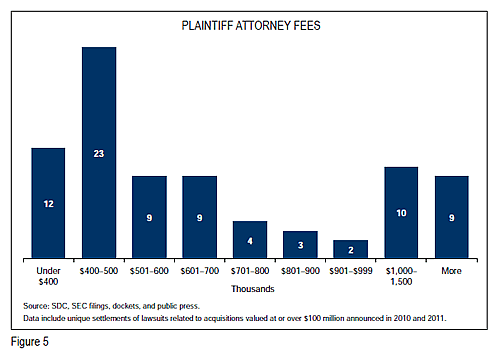
Table 8 shows all identified instances of plaintiff attorney fees in excess of $2 million in 2010 and 2011. By far, the highest fee was in the Del Monte Foods settlement, which also included a large payment to Del Monte’s shareholders. However, other large plaintiff attorney fees shown in the table were not necessarily associated with large shareholder payments, and several were not associated with any shareholder payments. The amount of attorney fees relative to the settlement payment also varied greatly—from 7 percent in the case of Student Loan Corporation to 71 percent for Protection One, Inc.
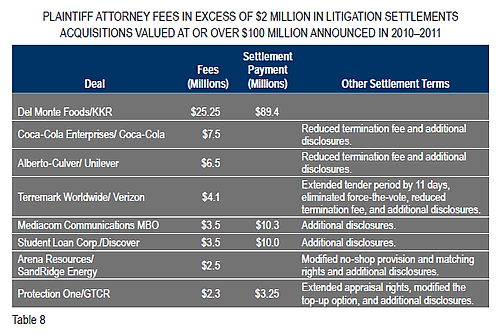
Endnotes
[1] For historical comparison, we also collected information on M&A shareholder litigation of deals valued over $500 million and announced in 2007. Statistics on the deals announced in 2011 exclude the acquisitions announced after December 15, for which no proxies have been filed with the SEC.
(go back)
[2] Typical deal protection provisions of merger agreements include termination (break-up) fees that the target has to pay to the acquirer if the target terminates the deal under certain circumstances, no-solicitation (no-shop) provisions that prevent the target from negotiating with additional bidders unless presented with a potentially superior bid, and matching rights that allow the acquirer to match a superior offer.
(go back)
[3] The Thompson Reuters SDC Platinum database reported that 195 deals valued over $500 million were announced in 2007, and only 108 and 80 such deals were announced in 2010 and 2011, respectively. This count excludes the following acquisitions reported by the SDC:
(1) unsolicited bids rejected by the targets;
(2) share repurchases, block purchases, and convertible notes tender offers mistakenly reported as acquisitions;
(3) foreign targets mistakenly reported as U.S. companies;
(4) targets that do not file with the SEC;
(5) asset sales from bankruptcy; and
(6) second bids for the same target (litigation is often filed for the first bid, and then allegations are modified to address the second bid).
(go back)
[4] See, for example, John Armour, Bernard S. Black, and Brian R. Cheffins, “Delaware’s Balancing Act,” working paper, July 2011. See also Matthew D. Cain and Steven M. Davidoff, “Delaware’s Competitive Reach,” Journal of Empirical Legal Studies, forthcoming 2012.
(go back)
[5] Of the targets in our sample, 70 percent were incorporated in Delaware.
(go back)
[6] See, for example, John Armour, Bernard S. Black, and Brian R. Cheffins, “Delaware’s Balancing Act,” working paper, July 2011. See also Matthew D. Cain and Steven M. Davidoff, “Delaware’s Competitive Reach,” Journal of Empirical Legal Studies, forthcoming 2012.
(go back)
[7] Figure 3 shows the courts of filing on the deal level as opposed to the level of lawsuit shown in Table 5.
(go back)
[8] Of the 1,485 reported lawsuits related to acquisitions valued at or over $100 million announced in 2010–2011, 745 were consolidated or stayed. Of the 740 lawsuits that proceeded, ninety are still pending, and we have not been able to determine the status of the remaining eighty-five lawsuits.
(go back)
[9] Thompson, Robert B. and Randall S. Thomas, “The New Look of Shareholder Litigation: Acquisition-Oriented Class Actions,” 57 Vanderbilt Law Review, 133 (2004).
(go back)
[10] Several lawsuits often settle together. In these cases, all lawsuits are included in the number of settled lawsuits (389), but the settlement is counted only once in the number of unique settlements (190).
(go back)
[11] Most target companies stop filing with the SEC after the merger closes, and therefore, data on postmerger settlements are not available in SEC filings.
(go back)
[12] The total number of lawsuits where both the filing date and the settlement date were available. In most cases, the settlement date is the date on which the parties signed a memorandum of understanding that first defines the preliminary settlement terms.
(go back)
[13] Thompson, Robert B. and Randall S. Thomas, “The New Look of Shareholder Litigation: Acquisition-Oriented Class Actions,” 57 Vanderbilt Law Review, 133 (2004).
(go back)
[14] A tenth company, Buckeye GP Holdings, reported that it agreed to pay $900,000 “in settlement of the plaintiffs’ claims (including any claim against the defendants by the plaintiffs’ counsel for attorneys’ fees or expenses related to the litigation).” Buckeye GP Holdings Form 10-Q filed on November 8, 2010. It is not clear whether any of this amount was paid to shareholders.
(go back)
[15] In re Del Monte Foods Company Shareholders Litigation, C.A. No. 6027-VCL, 2011 WL 532014 (Del. Ch. February 14, 2011), Opinion by Vice Chancellor Laster.
(go back)
[16] In re Del Monte Foods Company Shareholders Litigation, “Stipulation and Agreement of Compromise and Settlement,” filed with the Delaware Court of Chancery on October 6, 2011.
(go back)
[17] Most of the fee amounts are those reported in settlement summaries contained in SEC filings, not the fees approved by courts.
(go back)
 Print
Print